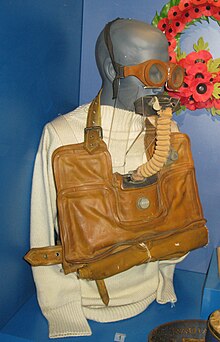DSEA

A Davis Submerged Escape Apparatus
|
|
| Acronym | DSEA |
|---|---|
| Uses | Oxygen rebreather for submarine emergency escape and diving |
| Inventor | Sir Robert Davis, 1910 |
| Related items | Escape set |
The Davis Submerged Escape Apparatus (also referred to as DSEA), was an early type of oxygen rebreather invented in 1910 by Sir Robert Davis, head of Siebe Gorman and Co. Ltd., inspired by the earlier Fleuss system, and adopted by the Royal Navy after further development by Davis in 1927. While intended primarily as an emergency escape apparatus for submarine crews, it was soon also used for diving, being a handy shallow water diving apparatus with a thirty-minute endurance, and as an industrial breathing set.
The DSEA rig comprises a rubber breathing/buoyancy bag, which contains a canister of barium hydroxide to scrub exhaled CO2 and, in a pocket at the lower end of the bag, a steel pressure cylinder holding approximately 56 litres of oxygen at a pressure of 120 bar. The cylinder is equipped with a control valve and is connected to the breathing bag. Opening the cylinder's valve admits oxygen to the bag and charges it to the pressure of the surrounding water.
The canister of CO2 absorbent inside the breathing bag is connected to a mouthpiece by a flexible corrugated tube; breathing is carried out by the mouth only, the nose being closed by a clip. Goggles are also provided as a standard part of the apparatus.
The breathing/buoyancy bag is fitted with a non-return release valve which allows air to escape from the bag as the user ascends towards the surface and the water pressure decreases. The wearer can close this valve on reaching the surface, the air in the breathing/buoyancy bag then serving as a life preserver. If the bag becomes deflated while the wearer is on the surface awaiting rescue, it can be refilled (for use as a lifejacket) by opening the non-return valve and blowing through the mouthpiece.
The usual Royal Navy DSEA rig also included an emergency buoyancy bag on the front of the main breathing/buoyancy bag to help keep the wearer afloat after reaching the surface even if he had exhausted the air in the breathing/buoyancy bag. This emergency bag was inflated by an "Oxylet" canister inside it - a small steel oxygen cylinder which was opened by breaking its weakened neck and wrenching sharply.
...
Wikipedia
